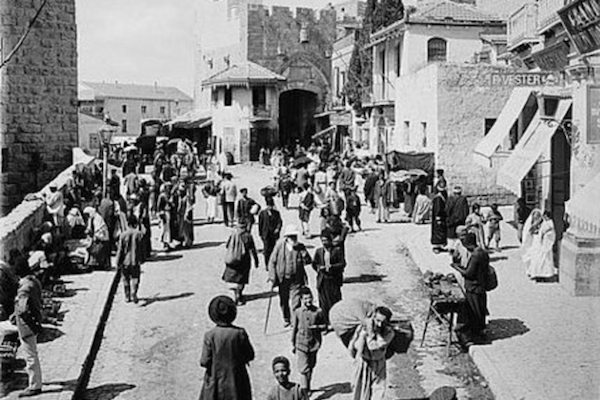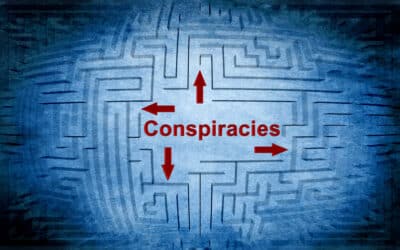One might have thought that, in the wake of the Nazi regime’s systematic crimes against humanity last century, dehumanization would have become unthinkable once and for all. Unfortunately, this has not been the case. It has shamefully continued unabated, the assorted perpetrators including, with tragic irony, those who themselves were victims of Nazi dehumanization.
Dehumanization is an apt term because it consists of more than merely murder, massacre, torture, blockade, dispossession, humiliation, and the like. It consists of the very denial of the humanity of the victims and their cultures; it may include attempts to wipe them from the archives and from anyone’s memory. This denial makes simple physical destruction easier: cruel treatment on a mass scale would seem to require that the victimizer view the victim as subhuman, as verminous, as something that infests the surroundings, as something unworthy of the consideration one normally gives even strangers about whom one knows nothing.
The case of the Palestinians is hardly the only case of dehumanization in the post-World War II era. Off the top of my head, I think of the African victims of the European powers (the mistreatment of whom got underway well before the 1930s), of Maoist China, of South Africa, of Rwanda, of Darfur, of Cambodia, of the Central African Republic. What seems to distinguish the Palestinian case (which of course began before World War II) is the sophistication, duration, and outside support of the effort to deny the very existence of people, Muslims and Christians, who have lived for a long time south of Syria and Lebanon and north of Saudi Arabia between the Mediterranean Sea and the Jordan River.
No one vocalized this denial better than a former Israeli prime minister, Golda Meir, who famously said:
There were no such thing as Palestinians. When was there an independent Palestinian people with a Palestinian state? It was either southern Syria before the First World War, and then it was a Palestine including Jordan. It was not as though there was a Palestinian people in Palestine considering itself as a Palestinian people and we came and threw them out and took their country away from them. They did not exist.
A libertarian approach to this matter offers a perspective that tends to get overlooked by conventional analysis. Examining whether the Palestinians as a group constitute a “people” deserving of “national” self-determination or liberation can yield useful information, but that question cannot be fundamental because whether or not “Palestinians” qua communally conscious people lived in “Palestine” before the Israeli statehood movement (Zionism) got underway, we do know this: individual human beings who were not recent European Jewish immigrants legitimately owned property there.
We have no good alternative to methodological individualism; human beings come in individual units. So the individual and his or her rights — including the right to land justly acquired — must have primacy. However important a person’s identification with an ethnic, racial, or national group, or lack thereof, may be, it has no bearing on the question of rights. A “Palestinian” can have no more rights than an unattached atomistic individual or one who identifies as an Asian, an Arab, or a Nabulsi. Therefore, individual self-determination must precede communal self-determination if the latter is to be valid because group rights make sense only if they extend from and are consistent with members’ individual rights.
Morally, we have rights by virtue of our personhood, not by virtue of our inclusion in a subgroup of persons. The idea of rights not rooted in the individual literally is nonsense. Among other things, this means there is no Jewish land, Palestinian land, or land with any other ethnic, racial, or religious qualifier. There is only legitimately and illegitimately acquired land. (In this connection, see this remarkable video of Khaled Sabawi, which focuses on his attempt to reestablish individual property rights in the West Bank through formal registration.)
Thus, even had Golda Meir been right, the establishment of Israel as it took place would have been no less a crime against the territory’s indigenous inhabitants. Likewise, even if one could show that the non-Jews driven from Palestine at gunpoint in 1948 had only recently migrated from elsewhere in the Middle East (which one cannot), this in itself could not justify their expulsion.
But in fact, notwithstanding fabricated and wholly discredited “histories” of Palestine and Israel, it is now uncontroversial to state that the establishment of Israel saw hundreds of thousands of indigenous individuals driven from their ancestral homes and hundreds of others massacred by recent European immigrants (many of them atheists yet nevertheless claiming to be Jewish) with a tenuous connection to Palestine or ancient Israel. H. G. Wells posed a reasonable question: “If it is proper to ‘reconstitute’ a Jewish state which has not existed for two thousand years, why not go back another thousand years and reconstitute the Canaanite state? The Canaanites, unlike the Jews, are still there.” (Quoted in Ian Gilmour and David Gilmour, “Pseudo-Travellers,” London Review of Books, February 1985.) What did Wells mean? The Gilmours explain:
The modern Palestinians are a people of various ethnic origins, descended from the conquerors of Palestine since early Biblical times. Their ancestors are the Canaanites and Philistines who, unlike the Jews, were never deported. They remained in Palestine (which took its name from the Philistines) and their descendants formed, and still form, the core of the indigenous population. In the seventh century, the Muhammadan Arabs brought with them their government, their language and their religion, and a majority of the inhabitants accepted all three. Palestine and its people became Arabised. Yet they remained the same people. There was little racial change in the population because the Arab conquerors were so few in number.
Evidence for this comes from an interesting source, David Ben-Gurion, Israel’s first prime minister, and Itzhak Ben-Zvi, Israel’s second president (and also an historian), in their 1918 book, Eretz Israel in the Past and in the Present. As quoted in Shlomo Sand’s The Invention of the Jewish People, Ben-Gurion and Ben-Zvi wrote:
The fellahin [Palestinian farmers] are not descendants of the Arab conquerors, who captured Eretz Israel and Syria in the seventh century CE. The Arab victors did not destroy the agricultural population they found in the country. They expelled only the alien Byzantine rulers, and did not touch the local population. Nor did the Arabs go in for settlement. Even in their former habitations, the Arabians did not engage in farming.… They did not seek new lands on which to settle their peasantry, which hardly existed. Their whole interest in the new countries was political, religious and material: to rule, to propagate Islam and to collect taxes.
Sand tells us that “historical reason indicates that the population that survived since the seventh century had originated from the Judean farming class that the Muslim conquerors had found when they reached the country.” He then continues with Ben-Gurion and Ben-Zvi’s text:
To argue that after the conquest of Jerusalem by Titus and the failure of the Bar Kokhba revolt Jews altogether ceased to cultivate the land of Eretz Israel is to demonstrate complete ignorance of history and the contemporary literature of Israel…. The Jewish farmer, like any other farmer, was not easily torn from his soil, which had been watered with his sweat and the sweat of his forebears…. Despite the repression and suffering, the rural population remained unchanged.
Sand comments that “this was written thirty years before Israel’s Proclamation of Independence, which asserts that the whole people was forcibly uprooted…. Although the ancient Judean peasants converted to Islam, they had done so for material reasons — chiefly to avoid taxation — which were in no way treasonous. Indeed, by clinging to their soil they remained loyal to their homeland.”
Sand notes that Ben-Zvi’s 1929 book, Our Population in the Country, took a more “moderate” position on who the fellahin were: “Obviously it would be mistaken to say that all the fellahin are descendants of the ancient Jews, but it can be said of most of them, or their core.” Ben-Zvi also added a second reason for their religious conversion: in Sand’s words, the “fear of being displaced from the soil.” Sand writes that Ben-Zvi’s later book
maintained that immigrants arrived from many places, and the local population was fairly heterogeneous, but the traces left in the language, place-names, legal customs, popular festivals such as that of Nebi Musa (the prophet Moses), and other cultural practices left almost no doubt that “the great majority of the fellahin do not descend from the Arab conquerors but before that, from the Jewish fellahin, who were the foundation of this country before its conquest by Islam.”
History supports this thesis. Sand’s book documents that neither the Romans in the first century CE nor the Arab Muslims six centuries later exiled the Jews:
It must first be emphasized that the Romans never deported entire peoples…. It did not pay to uproot the people of the land, the cultivators of produce, the taxpayers…. They definitely did not deport whole populations in the countries they conquered in the East, nor did they have the means to do so — none of the trucks, trains or great ships available to the modern world.
This stunning fact, support for which Sand found among historians specializing in the area, undermines the official narrative that the modern state of Israel was founded and peopled by long-wandering exiles who finally returned home. Sand explains in various lectures that when he was researching his book he was shocked to find no histories of the Roman exile in the Tel Aviv University library. When he consulted the experts in the university’s department of Jewish history, he said he was told, “It wasn’t exactly an exile.” Thus was vindicated the American Reform Jewish movement, which declared in 1885 that it did not regard the Jews outside of Palestine as constituting a diaspora longing to return “home”: “We consider ourselves no longer a nation, but a religious community, and therefore expect neither a return to Palestine, nor a sacrificial worship under the sons of Aaron, nor the restoration of any of the laws concerning the Jewish state.” In 1841, Allan Brownfeld of the American Council for Judaism reports, Rabbi Gustav Poznanski of Temple Beth Elohim in Charleston, South Carolina, spoke for his co-religionists when he said, “This country is our Palestine, this city our Jerusalem, this house of God our temple.” In our time, the idea of a diaspora is disappearing. Jane Eisner, in the Jewish publication The Forward, says “the negative connotation of ‘Diaspora’ formulated in classic Zionism is fading — with so many Israelis living in Los Angeles and Berlin, how could it not?” She’s pro-Israel, yet she writes, “Let’s leave behind the outdated notion of ‘Diaspora.'” (A few years ago the Israeli newspaper Haaretz reported that Berlin had the “world’s fastest growing Jewish community.”)
The early Zionist affinity for the indigenous population of Palestine faded, Sand writes, when it began to resist the encroachments by the European Jewish newcomers. Sand writes:
From that moment on, the descendants of the Judean peasantry vanished from the Jewish national consciousness and were cast into oblivion. Very soon the modern Palestinian fellahin became, in the eyes of the authorized agents of memory, Arabian immigrants who came in the nineteenth century to an almost empty country and continued to arrive in the twentieth century as the developing Zionist economy, according to the new myth, attracted many thousands of non-Jewish laborers.
The upshot is that since before Biblical times, people have lived continuously in Palestine. Every emissary who scouted the area for Theodor Herzl and his new Zionist project reported the same thing: Palestine was not “a land without a people,” contrary to the claim made in the 1948 Declaration of the Establishment of the State of Israel.
As the Gilmours point out, Ahad Ha’am, a “spiritual Zionist” who had spent time there, reported in 1891, “‘Palestine is not an uninhabited country,’ and has room ‘for only a very small proportion of Jews,’ since there was little untilled soil except for stony hills or sand dunes.” Ha’am and others warned the Zionist movement to respect the indigenous population. They were not heeded.
Thus if there was to be a Jewish state, most if not all of the non-Jews would have to go. “Only in a very few places in our colonialisation were we not forced [sic] to transfer the earlier residents,” Ben-Gurion told the 1937 Zionist Congress” (Gilmours). His militias would “be forced” to transfer many more a decade later.
To repeat, it’s a secondary matter whether these individuals thought of themselves as “Palestinians” or whether they perceived themselves to be living in a country called Palestine. They were individuals with rights, and they were dispossessed and made into refugees when they weren’t murdered.
As individual human beings, they obviously cared about their homes and communities, whether rural or urban, and thus could be counted on to resist proposals that they be “transferred” — expelled — from their homes to somewhere else — even to places where people spoke a similar language (though the dialects might differ) and practiced the same religion. To assume otherwise is to see these individuals as less than human.
In fact, though, we can find signs of “national” (for lack of a better term in the context of anti-colonial resistance) self-consciousness at different times and in different stages of development. “Islam and the Ottoman Empire were the broadest and most meaningful socio-cultural and political entities, but there developed a type of proto-national sense regarding Filastin, as it was termed, from the seventeenth century on,” writes Khaled M. Safi, a historian at Al-Aqsa University. Safi quotes a distinguished historian of the Arab world, Albert Hourani (“The Fertile Crescent in the Eighteenth Century” in A Vision of History: Near Eastern and Other Essays, 1961):
Since the central [Ottoman] Government could no longer control the Empire, it could no longer serve as the focus of loyalty and solidarity. Thus we can observe in the course of the eighteenth century a strengthening of the communal loyalties which had always formed the basis of Ottoman society, and a regrouping of the peoples of the Empire around those authorities which could give them what the Imperial Government no longer gave: a defense against disorder and a system of law regulating the relations of man and man.
Hourani continued: “It was the pressure of these local forces which gave a new form to the relationship between the Ottoman Government and the provinces. All over the Empire, there arose local ruling groups loyal to the Sultan but possessing a force, a stability and to some degree an autonomy of their own. It was only through the mediation of these groups that the Ottoman Empire was still able to keep some sort of moral and material hold on its subjects.”
Palestinian consciousness, however, seems to have preceded the 17th century. The famous 10th-century Arab geographer Al-Muqaddasi, who was born in Jerusalem, describes Palestine (or Filastin) in great detail, including its lush farmland and nourishing natural waters, in his book, Description of Syria, Including Palestine. Nazmi Al-Ju’beh, an historian at Birzeit University, writes in “Palestinian Identity and Cultural Heritage” that Al-Muqaddasi “uses the terminology ‘Palestine’ and ‘Palestinian’ with the clear-cut meaning of geographic belonging and identity.”
Later, inhabitants of Palestine resisted Napoleon’s army and in 1834, peasants there rebelled, unsuccessfully, against the taxes and conscription imposed by the Egyptian Ibrahim Pasha. Such threats from perceived foreigners tend to create a communal consciousness. Safi concludes, “The revolt [against the Egyptians, that is, against other Arab Muslims] indicates the presence of an embryonic territorial and therefore social and political awareness.”
In the early 1920s, after the French (under the Sykes-Picot Agreement) forbade independent Arab rule of greater Syria, of which Palestine was regarded as the southern province, Arab leaders were determined to defend the independence of Palestine. The British of course would have none of that; it ruled Palestine under the League of Nations mandate system that incorporated the 1917 Balfour Declaration‘s endorsement of the “establishment in Palestine of a national home for the Jewish people.” The victims of British and French duplicity, like their forebears, tended to develop, or rather increase, a communal identity. This identity was already solidifying as the Zionist plan for an exclusivist state became a reality on the ground through the eviction of fellahin and city dwellers from properties purchased by Jewish individuals and organizations; in Zionists’ eyes these were Jewish lands that had to be redeemed after their defilement by non-Jews. (Stephen Halbrook’s valuable “The Alienation of a Homeland” shows that only a small percentage of those properties were purchased from individual tillers of the soil. Most were acquired from absentee feudal landlords in Beirut and elsewhere who had never established ownership in a Lockean manner, that is, by mixing their labor with the land.)
The dehumanization of the Palestinians was manifest in the Western attitude that these individuals saw themselves merely as undifferentiated members of an Arab horde, indifferent to their immediate surroundings, that is, to their homes, towns, villages, farming communities, market relations, and ultimately their larger homeland, and thus would accept “transfer” to other Arab areas. No westerner ever thought of himself in such nonhuman terms, but thinking of Palestinians that way came easy. That’s the stuff of mass injustice, of literal and cultural genocide.
Realization of the dream of a Jewish state logically entailed the dispossession and expulsion of the Palestinians, who by the common standard of justice were legitimate owners of their land. Those who remained were made third-class citizens or even worse in an apartheid state. The countless micro offenses against those individuals were compounded by a macro offense: the destruction of their flourishing culture, communities, and country.































